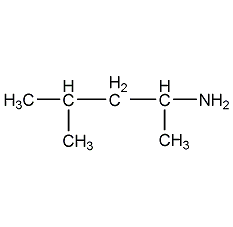
Structural formula
| Business number | 02WC |
|---|---|
| Molecular formula | C6H15N |
| Molecular weight | 101.19 |
| label |
1,3-Dimethyl-n-butylamine, 2-amino-4-methylpentane, 2-Amino-4-methylpentane, (CH3)2CHCH2CH(CH3)NH2 |
Numbering system
CAS number:108-09-8
MDL number:MFCD00008088
EINECS number:203-549-6
RTECS number:EO4460000
BRN number:None
PubChem number:24847726
Physical property data
1. Properties: colorless liquid with unpleasant odor. [1]
2. Boiling point (℃): 106~109[2]
3. Relative density (water =1): 0.75[3]
4. Relative vapor density (air=1): 3.5[4]
5. Flash point (℃): 12.78 (OC) [5]
6. Solubility: insoluble in water [6]
Toxicological data
1. Skin/eye irritation
Standard Draize test: rabbit, skin contact: 500mg, severity of reaction: severe.
2. Acute toxicity:
Oral LDLo in rats: 600mg/kg; oral LD50 in mice: 470mg/kg; inhaled LCLo in mice: 1278ppm/15M; small Rat intravenous LD50: 80mg/kg; rabbit skin contact LD50: 600mg/kg;
3. Acute toxicity [7]
LD50: 600mg/kg (oral in rats); 470mg/kg (oral in mice); 600mg/kg (transdermal in rabbits)
4. Irritation[8] Rabbit transdermal: 500mg, severe irritation.
Ecological data
1. Ecotoxicity No data available
2. Biodegradability No data available
3 .Non-biodegradability No data yet
4. Other harmful effects[9] This substance may be harmful to the environment and is harmful to the environment. Bodies of water should be given special attention.
Molecular structure data
1. Molar refractive index: 42.57
2. Molar volume (cm3/mol): 164.3
3. Isotonic specific volume (90.2K ): 369.6
4. Surface tension (dyne/cm): 25.5
5. Polarizability (10-24cm3): 16.87
Compute chemical data
1. Reference value for hydrophobic parameter calculation (XlogP): 1.4
2. Number of hydrogen bond donors: 1
3. Number of hydrogen bond acceptors: 1
4. Number of rotatable chemical bonds: 2
5. Number of tautomers: none
6. Topological molecule polar surface area 26
7. Number of heavy atoms: 7
8. Surface charge: 0
9. Complexity: 41.4
10. Number of isotope atoms: 0
11. Determine the number of atomic stereocenters: 0
12. Uncertain number of atomic stereocenters: 1
13. Determine the number of chemical bond stereocenters: 0
14. Number of uncertain chemical bond stereocenters: 0
15. Number of covalent bond units: 1
Properties and stability
1. Stability[10] Stable
2. Incompatible materials [11] Acids, acid chlorides, acid anhydrides , carbon dioxide, strong oxidants
3. Polymerization hazards[12] No polymerization
Storage method
Storage Precautions[13] Store in a cool, ventilated warehouse. Keep away from fire and heat sources. The storage temperature should not exceed 37°C. Keep container tightly sealed. They should be stored separately from oxidants, acids, etc., and avoid mixed storage. Use explosion-proof lighting and ventilation facilities. It is prohibited to use mechanical equipment and tools that are prone to sparks. The storage area should be equipped with emergency release equipment and suitable containment materials.
Synthesis method
None
Purpose
1. Used as an intermediate in organic synthesis. [14]

 微信扫一扫打赏
微信扫一扫打赏

